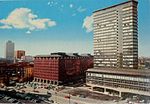Gioia (Milan Metro)
1971 establishments in ItalyItalian railway station stubsMilan Metro stationsMilan Metro stubsRailway stations opened in 1971

Gioia is a station on Line 2 of the Milan Metro. The station was opened on 21 July 1971 as part of the extension from Centrale to Garibaldi FS.The station is located between Via Melchiorre Gioia and Via Giovanni Battista Pirelli, within the territory of the municipality of Milan. It is also the focus of the Management Center of Milan. This is an underground station, with two tracks in two separate tunnels.
Excerpt from the Wikipedia article Gioia (Milan Metro) (License: CC BY-SA 3.0, Authors, Images).Gioia (Milan Metro)
Via Melchiorre Gioia, Milan Municipio 9
Geographical coordinates (GPS) Address Nearby Places Show on map
Geographical coordinates (GPS)
| Latitude | Longitude |
|---|---|
| N 45.484722222222 ° | E 9.1952777777778 ° |
Address
Via Melchiorre Gioia
Via Melchiorre Gioia
20124 Milan, Municipio 9
Lombardy, Italy
Open on Google Maps









